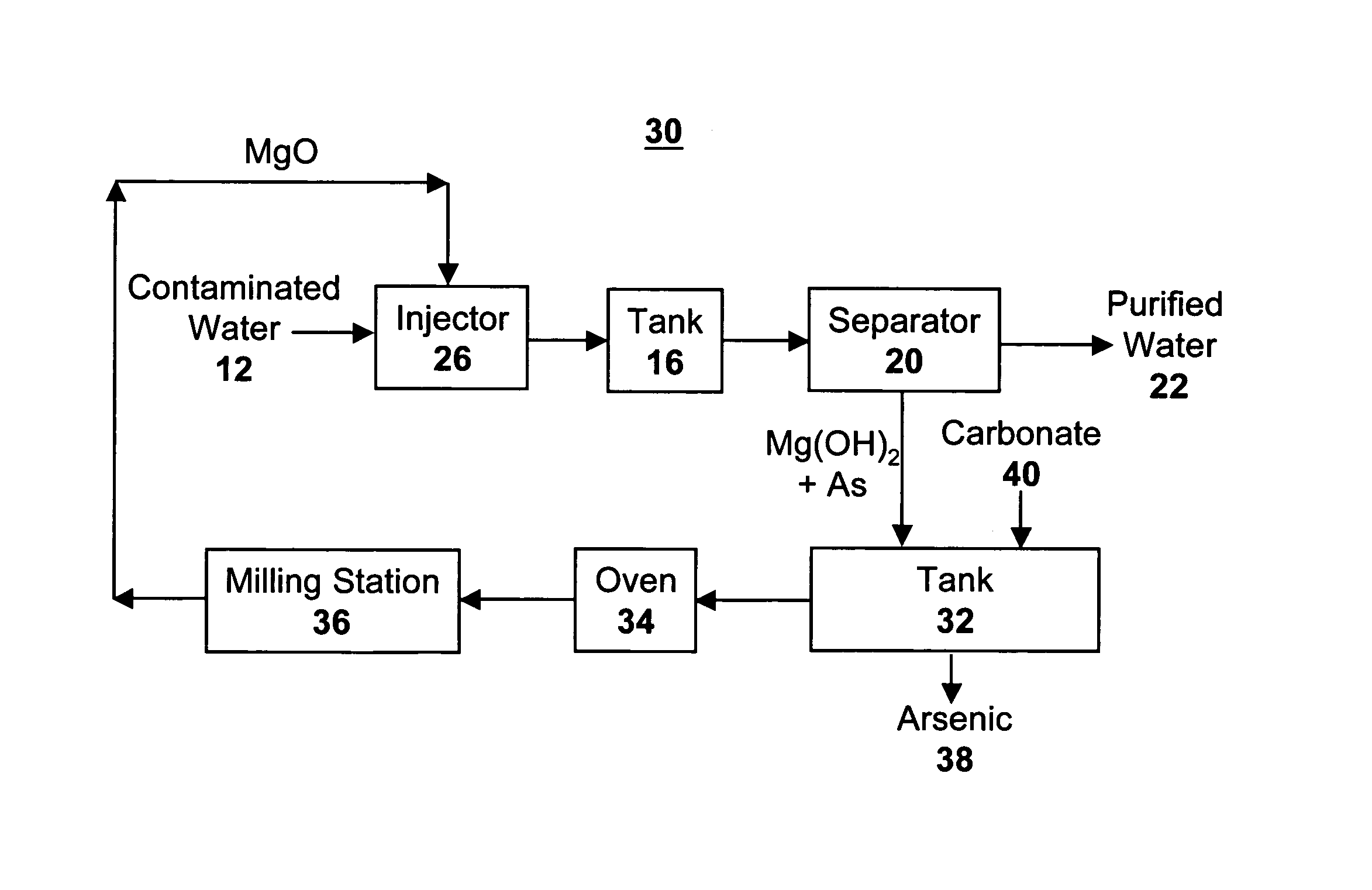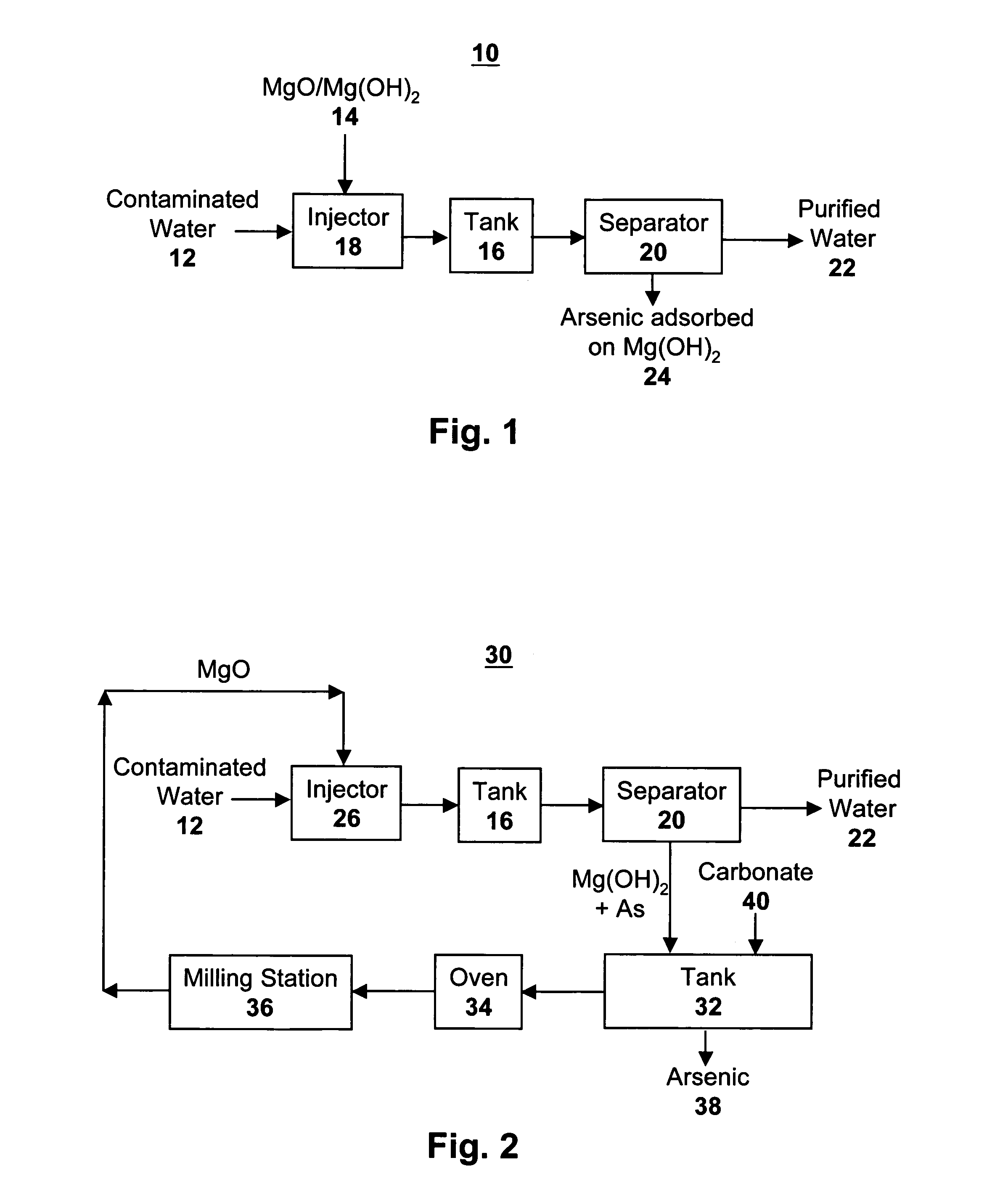Arsenic removal from water
a technology of arsenic and water, applied in the direction of water/sewage treatment by ion exchange, filtration separation, separation processes, etc., can solve the problems of inability to the prior art methods do not meet the requirements of efficient removal of arsenic, and the quantitative measurement of arsenic concentration in water at 1-50 ppb requires expensive and complex equipment, and achieves rapid adsorption, facilitate quantification of ars
- Summary
- Abstract
- Description
- Claims
- Application Information
AI Technical Summary
Benefits of technology
Problems solved by technology
Method used
Image
Examples
example 1
[0049]Batch tests were performed by placing small quantities of Mg(OH)2 in water with a known concentration of arsenic in the +5 oxidation state. The mixtures were shaken and samples were removed at varying time intervals. The results from batch tests with arsenic in deionized water spiked with additional arsenic is given in Table 1 below. The results show that Mg(OH)2 strongly adsorbed arsenic from the water and that it can be used to remove arsenic from water in a water treatment process.
[0050]
TABLE 1Adsorption of Arsenic (As) from Deionized Water using Mg(OH)2after Two Minutes Contact TimeMg(OH)2 added to 1 literArsenic InitialArsenic Finalof waterConcentration (ppb)Concentration (ppb)0.1 g250400.2 g250220.5 g2504
example 2
[0051]A second test was conducted as in Example 1 above, using MgO rather than Mg(HO)2, utilizing tap water obtained from the water distribution system for the city of Albuquerque, N. Mex. This source of tap water contained a carbonate concentration of approximately 150 ppm (parts per million).
[0052]
TABLE 2Sorption of Arsenic (As) on MgO in Albuquerque TapWaterArsenicArsenicMgO in waterInitialTime,Final% Arsenic(g / L)(ppb)minutes(ppb)Removed0.05126293.625.710.05126588.629.680.051261093.126.110.051263037.969.920.1126268.145.950.1126541.167.380.11261039.168.970.11263011.590.870.512626.694.760.512653.697.140.5126103.597.220.512630199.21
The results shown in Table 2 indicate that addition of 0.1 grams of Mg per liter of water causes a 91% reduction of the arsenic concentration after 30 minutes of contact time, from 126 ppb to 11.5 ppb. Also, Table 2 shows that addition of 0.5 grams of MgO per liter of water causes a 99% reduction of the arsenic concentration after 30 minutes of contact ti...
example 3
[0055]1 g of MgO was added to 1 L of water containing various initial concentrations of arsenic. The solution was filtered to remove the Mg(OH)2 resulting from reaction of MgO with water. The filtered water was tested by ion-coupled plasma mass spectroscopy (I-C PMS), and had essentially no detectable arsenic. The filtrate, containing the Mg(OH)2 resulting from reaction of MgO with water, was then added to a solution containing potassium bicarbonate in 100 mL of water. The potassium bicarbonate resulted in conversion of Mg(OH)2 to MgCO3, with concomitant desorption of the arsenic. This water was then tested for arsenic content, as shown in Table 3. This illustrates both that the arsenic was effectively concentrated by a factor of ten due to decrease in water concentration from 1 L to 100 mL, and that the initial 1 L of water, after filtration to remove Mg(OH)2, was substantially pure with no detectable arsenic.
[0056]
TABLE 3Arsenic Concentrations determined by I-C PSMArsenic Concentr...
PUM
| Property | Measurement | Unit |
|---|---|---|
| Fraction | aaaaa | aaaaa |
| Fraction | aaaaa | aaaaa |
| Time | aaaaa | aaaaa |
Abstract
Description
Claims
Application Information
 Login to View More
Login to View More - R&D
- Intellectual Property
- Life Sciences
- Materials
- Tech Scout
- Unparalleled Data Quality
- Higher Quality Content
- 60% Fewer Hallucinations
Browse by: Latest US Patents, China's latest patents, Technical Efficacy Thesaurus, Application Domain, Technology Topic, Popular Technical Reports.
© 2025 PatSnap. All rights reserved.Legal|Privacy policy|Modern Slavery Act Transparency Statement|Sitemap|About US| Contact US: help@patsnap.com


